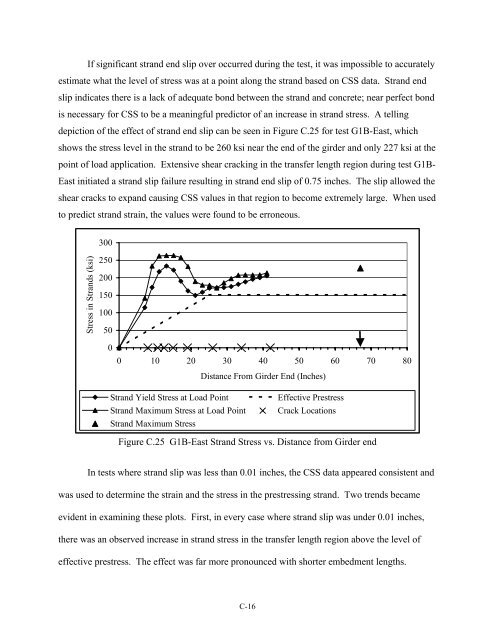Lightweight Concrete for High Strength - Expanded Shale & Clay
Lightweight Concrete for High Strength - Expanded Shale & Clay
Lightweight Concrete for High Strength - Expanded Shale & Clay
You also want an ePaper? Increase the reach of your titles
YUMPU automatically turns print PDFs into web optimized ePapers that Google loves.
If significant strand end slip over occurred during the test, it was impossible to accurately<br />
estimate what the level of stress was at a point along the strand based on CSS data. Strand end<br />
slip indicates there is a lack of adequate bond between the strand and concrete; near perfect bond<br />
is necessary <strong>for</strong> CSS to be a meaningful predictor of an increase in strand stress. A telling<br />
depiction of the effect of strand end slip can be seen in Figure C.25 <strong>for</strong> test G1B-East, which<br />
shows the stress level in the strand to be 260 ksi near the end of the girder and only 227 ksi at the<br />
point of load application. Extensive shear cracking in the transfer length region during test G1B-<br />
East initiated a strand slip failure resulting in strand end slip of 0.75 inches. The slip allowed the<br />
shear cracks to expand causing CSS values in that region to become extremely large. When used<br />
to predict strand strain, the values were found to be erroneous.<br />
300<br />
Stress in Strands (ksi)<br />
250<br />
200<br />
150<br />
100<br />
50<br />
0<br />
0 10 20 30 40 50 60 70 80<br />
Distance From Girder End (Inches)<br />
Strand Yield Stress at Load Point<br />
Strand Maximum Stress at Load Point<br />
Strand Maximum Stress<br />
Effective Prestress<br />
Crack Locations<br />
Figure C.25 G1B-East Strand Stress vs. Distance from Girder end<br />
In tests where strand slip was less than 0.01 inches, the CSS data appeared consistent and<br />
was used to determine the strain and the stress in the prestressing strand. Two trends became<br />
evident in examining these plots. First, in every case where strand slip was under 0.01 inches,<br />
there was an observed increase in strand stress in the transfer length region above the level of<br />
effective prestress. The effect was far more pronounced with shorter embedment lengths.<br />
C-16















